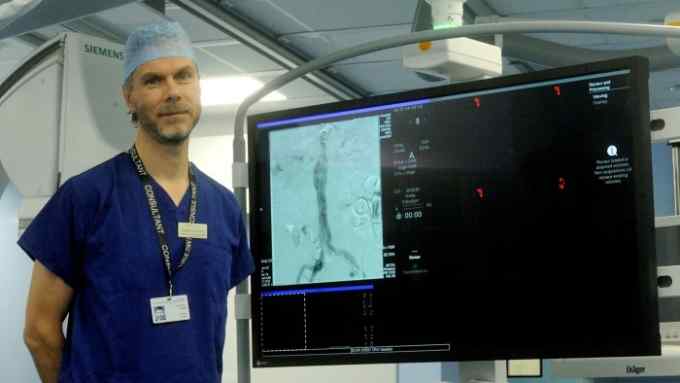Meet the advocates of using contracts to gauge economic health

Simply sign up to the Global Economy myFT Digest -- delivered directly to your inbox.
A group of economists no longer satisfied with gross domestic product as the best way to measure the health of modern economies are looking for help via an unlikely source: the humble contract.
Contracts are the connective tissue in modern economies, said Oliver Hart, the British-American economist, when he accepted the Nobel Prize for economics in 2016. That set a few innovative economists thinking: could contract volumes improve a country’s insights into its economic health?
“If you had a true picture of the volume of contracts running through a country, you would have a more accurate understanding of a whole range of economic activity, which would lead to better policymaking,” says Harald Stieber, a senior economist at the European Commission.
Mr Stieber has a history of finding new uses for contracts. A few years ago he helped pioneer a way to make financial contracts machine-readable for easier reporting. He was also involved in early work on the use of blockchain technology to track smart contracts.
He convinced the commission to look at using contract volume as a complement to GDP. A study into the subject was completed this year by Trakti, a British-Italian legal tech provider that looks at the use of blockchain to improve how contracts are negotiated, signed and stored.
“The [analysis] proved that studying the changing properties of contracting networks could help governments fine-tune policies,” says Mr Stieber.
The limits of GDP
Diane Coyle, Bennett professor of public policy at Cambridge university, argued in her 2015 book GDP: A Brief but Affectionate History, that it cannot measure the service industry and digital activities that make up so much of 21st century economies.
“GDP is a poor measure of many things in the economy, yet we fixate on it,” says Oxford university professor Doyne Farmer. “There are often large errors and the numbers can take a year or so to settle. And it doesn’t provide us with a measure of a country’s wealth or assets, only the flow of certain forms of economic activity.”

Prof Farmer is trying to map an ecology of contracts by using methods borrowed from biology. He hopes to gain a greater understanding of production activity and networks for individual companies.
“If you are able to track the flow of all contracts in an economy, I think it would give you a very good indicator of a country’s health,” he says. “Every transaction happens within the context of a contract — even if I buy a chocolate bar at my local shop, I am making an agreement with the shopkeeper that is an implied contract.”
As well as formal contractual relationships, both business-to-business and business-to-consumer, these implied contracts would be important for any contract volume measure trying to provide an accurate view of economic activity.
“Billions of these transactions happen every day and are an important part of economic activity,” says Prof Farmer. “These would need to be considered in any new measure.”
A practical measure?
Mr Stieber and Luigi Telesca, founder of Trakti, agree that for contract volume to be useful it would be crucial to capture every corner of economic activity — and they understand they would need to convince businesses to buy into the idea.
“The basics need to be robust, so that businesses of all sizes can easily and effortlessly provide information on contracts and transactions,” says Mr Stieber, who likens any potential system to the process of filing taxes.
The two see contract volume as a complement to GDP, rather than an alternative measure. The system they envision would provide economic health information much faster — perhaps even real time.
“We don't challenge the level of GDP, but its explanatory power,” says Mr Stieber. “We aim to build a complementary view to GDP that would help us answer policy questions across a vast number of areas, including competition, taxation, social justice and individual opportunity, and consumer protection.”
Mr Telesca’s company is part of an informal alliance called Open Trust Fabric, which is developing an open-source contracts ecosystem. He believes the freely available protocol would make it easier for businesses to share contract volume data while also ensuring no one software provider could monopolise development of the new measure.
Mr Stieber says Brussels is interested enough in how the idea develops to have commissioned the alliance to investigate creating a model of the EU economy as an ecosystem of contracts.
“As well as providing a complement to GDP, there are a number of obvious policy applications,” says Mr Stieber. “For instance, VAT and sales tax fraud should be technically impossible if you’re tracking contract volumes in the way the study explores, which includes a trusted data-sharing framework.”
Sally Guyer, chief executive of the World Commerce and Contracting Association (WorldCC), says it would be important to ascertain not only that the concept works but that it is scalable, so that it could genuinely be used by businesses without adding burdensome administration and red tape.
Her organisation represents more than 70,000 contract managers, procurement professionals and supply chain officers — the people who would be key to compiling data for a contract volume measure.
The WorldCC has long advocated increased standardisation and digitalisation of commercial contracts, as well as greater visibility of economic-level data from contracts.
“Without needing to disclose sensitive commercial information, contracts can provide a lot of extremely useful economic information, especially around the nature of business ecosystems and networks risks,” says Ms Guyer.
She admits the system would need the right balance of standardisation and anonymisation. But she nonetheless believes companies would share information in aggregate if they were convinced it would help build a more accurate picture of the economy.
“The Covid-19 pandemic has made us all more aware of the interconnectedness of businesses and the global economy,” says Ms Guyer. “In many ways, the European Commission’s initiative is a recognition of the underlying reality: a reset that reflects the need for a more frictionless world,” she says.
The case studies below are a shortlist of entries to the FT Intelligent Business awards event held online on November 19.
All the entries showcase the combined use of data and tech in business operations. Source: RSG Consulting
Contracting

Winner:
Shell
The oil and gas company has created a tool for procurement staff to draft contracts with fewer bespoke clauses, making negotiations faster and reducing risk. Some 8,000 contracts are generated annually using the tool. Shell has also implemented a virtual contracting assistant that uses natural-language processing to recognise whether a supplier's suggested amendments to a contract materially alter its performance. By the end of 2021, Shell expects that the assistant will review 70 per cent of its procurement contracts.
Campaign Zero and Kira Systems
Police reform group Campaign Zero launched in 2015 to develop research-based policies for ending police brutality in the US. In June, contract analysis specialist Kira Systems freely offered its document review technology to help the non-profit organisation review 600 police union contracts from across the country. The aim was to assess questions such as whether the terms give officers an unfair advantage over the ordinary citizen. Campaign Zero reported that Kira's technology increased the efficiency of contract review by 70 per cent, enabling it to publish findings at the height of the Black Lives Matter protests, increasing transparency and public scrutiny of the contracts.
Children’s National Hospital and Agiloft
The legal team for the Children’s National Hospital in Washington implemented workflow technology from Agiloft, a contract management company, and halved its contract turnround time. Managing the timeline of contract deliverables is valuable to the procurement team and to the hospital’s research institute, which must show returns on multimillion dollar investments. The CNH was the first paediatric hospital to open a drive-in Covid testing centre, in part thanks to the legal team using this contract workflow tool to facilitate quick agreements on supplies such as tents and testing materials.
Public Procurement Office, Lithuania, and the Open Contracting Partnership
The Open Contracting Partnership is a non-profit collaboration that lobbies to make government procurement more transparent through the open contracting data standard, a set of principles for publishing data from public procurement contracts.
Lithuania published its contract data at the start of the pandemic to ensure that equipment purchased at speed came from reputable suppliers. The country has committed to using the standard for all public procurement within its online procurement platform.

Comments